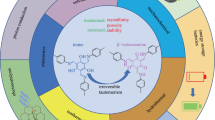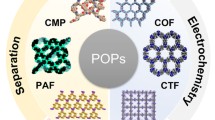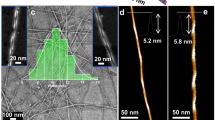Abstract
Achiral diacetylene 10,12-pentacosadinoic acid (PCDA) and a chiral low-molecular-weight organogelator could form co-gel in organic solvent and it could be polymerized in the presence of Zn(II) ion or in the corresponding xerogel under UV-irradiation. Optically active polydiacetylene (PDA) were subsequently obtained. Supramolecular chirality of PDA could be controlled by the chirality of gelators. Left-handed and right-handed helical fibers were obtained by using L- and D-gelators in xerogels respectively, and CD spectra exhibited mirror-image circular dichroism. The PDA in xerogel exhibited typical blue-to-red transition responsive to the temperature and pH, while the supramolecular chirality of PDA showed a corresponding change.
Similar content being viewed by others
References
Fujiki M, Koe JR, Terao K, Sato T, Teramoto A, Watanabe J. Optically active polysilanes. Ten years of progress and new polymer twist for nanoscience and nanotechnology. Polym J, 2003, 35: 297–344
Yashima E, Maeda K, Okamoto Y. Memory of macromolecular helicity assisted by interaction with achiral small molecules. Nature, 1999, 399: 449–451
Hopkins TE, Wagener KB. Chiral polyolefins. Adv Mater, 2002, 14: 1703–1715
Chen PL, Ma XG, Liu MH. Optically active phthalocyaninatopolysiloxane constructed from achiral monomers: From noncovalent assembly to covalent polymer. Macromolecules, 2007, 40:4780–4784
Yan Y, Yu Z, Huang Y W, Yuan W X, Wei Z X. Helical polyaniline nanofibers induced by chiral dopants by a polymerization process. Adv Mater, 2007, 19: 3353–3357
Nonokawa R, Yashima E. Detection and amplification of a small enantiomeric imbalance in alpha-amino acids by a helical poly (phenylacetylene) with crown ether pendants. J Am Chem Soc, 2003, 125: 1278–1283
Onouchi H, Maeda K, Yashima E. A helical polyelectrolyte induced by specific interactions with biomolecules in water. J Am Chem Soc, 2001, 123: 7441–7442
Charych DH, Nagy JO, Spevak W, Bednarski MD. Direct colorimetric detection of a receptor-ligand interaction by a ploymerized bilayer assembly. Science, 1993, 261: 585–588
Ma ZF, Li JR, Liu MH, Cao J, Zou ZY, Tu J, Jiang L. Colorimetric detection of Escherichia coli by polydiacetylene vesicles functionalized with glycolipid. J Am Chem Soc, 1998, 120: 12678–12679
Lu YF, Yang Y, Sellinger A, Lu MC, Huang JM, Fan HY, Haddad R, Lopez G, Burns AR, Sasaki DY, Lu YF, Yang Y, Sellinger A, Lu MC, Huang JM, Fan HY, Haddad R, Lopez G, Burns AR, Sasaki DY, Shelnutt J, Brinker CJ. Self-assembly of mesoscopically ordered chromatic polydiacetylene/silica nanocomposites. Nature, 2001, 410: 913–917
Reppy MA, Pindzola BA. Biosensing with polydiacetylene materials: structures, optical properties and applications. Chem Commun, 2007: 4317-4338
Sada K, Takeuchi M, Fujita N, Numata M, Shinkai S. Post-polymerization of preorganized assemblies for creating shape-controlled functional materials. Chem Soc Rev, 2007, 36: 415–435
Potisatityuenyong A, Rojanathanes R, Turncharern G, Sukwattanasinitt M. Electronic absorption spectroscopy probed side-chain movement in chromic transitions of polydiacetylene vesicles. Langmuir, 2008, 24: 4461–4463
Bhattacharya S, Acharya SNG. Impressive gelation in organic solvents by synthetic, low molecular mass, self-organizing urethane amides of L-phenylalanine. Chem Mater, 1999, 11: 3121–3132
Tamaoki N, Shimada S, Okada Y, Belaissaoui A, Kruk G, Yase K, Matsuda H. Polymerization of a diacetylene dicholesteryl ester having two urethanes in organic gel states. Langmuir, 2000, 16: 7545–7547
Masuda M, Hanada T, Okada Y, Yase K, Shimizu T. Polymerization in nanometer-sized fibers: Molecular packing order and polymerizability. Macromolecules, 2000, 33: 9233–9238
Huang WY, Matsuoka S, Kwei TK, Okamoto Y. Aggregation and gelation of fully conjugated rigid-rod polymers. Poly(2,5-dialkyl-1,4-phenyleneethynylene)s. Macromolecules, 2001, 34: 7166–7171
George M, Weiss RG. Low molecular-mass gelators with diyne functional groups and their unpolymerized and polymerized gel assemblies. Chem Mater, 2003, 15: 2879–2888
Deb P, Yuan ZZ, Ramsey L, Hanks TW. Synthesis and optical properties of chiral polydiacetylenes. Macromolecules, 2007, 40: 3533–3537
Hsu L, Cvetanovich GL, Stupp SI. Peptide amphiphile nanofibers with conjugated polydiacetylene backbones in their core. J Am Chem Soc, 2008, 130: 3892–3899
Drake AF, Udvarhelyi P, Ando DJ, Bloor D, Obhi JS, Mann S. Chiroptical spectroscopic studies of polydiacetylenes. Polymer, 1989, 30: 1063–1069
Wilson RB. Diacetylene monomers and polymers with chiral substituents: Structure, solid-state polymerization, and properties. J Am Chem Soc, 1982, 104: 509–515
Bloor D. FTIR-Raman spectroscopy of polydiacetylenes with chiral pendent groups. Polymer, 1999, 40: 3901–3908
Huang X, Liu MH. Chirality of photopolymerized organized supramolecular polydiacetylene films. Chem Commun, 2003: 66-67
Li YG, Wang TY, Liu MH. Gelating-induced supramolecular chirality of achiral porphyrins: chiroptical switch between achiral molecules and chiral assemblies. Soft Matter, 2007, 3: 1312–1317
Huang X, Jiang SG, Liu MH. Metal ion modulated organization and function of the Langmuir-Blodgett films of amphiphilic diacetylene: Photopolymerization, thermochromism, and supramolecular chirality. J Phys Chem B, 2005, 109: 114–119
Wenz G, Mueller MA, Schmidt M, Wegner G. Structure of poly(diacetylenes) in solution. Macromolecules, 1984, 17: 837–850
Percec V, Aqad E, Peterca M, Rudick JG, Lemon L, Ronda JC, De BB, Heiney PA, Meijer EW. Steric communication of chiral information observed in dendronized polyacetylenes. J Am Chem Soc, 2006, 128: 16365–16372
Hoeben FJM, Jonkheijm P, Meijer EW, Schenning A. About supramolecular assemblies of pi-conjugated systems. Chem Rev, 2005, 105: 1491–1546
Song J, Cheng Q, Kopta S, Stevens RC. Modulating artificial membrane morphology: pH-induced chromatic transition and nanostructural transformation of a bolaamphiphilic conjugated polymer from blue helical ribbons to red nanofibers. J Am Chem Soc, 2001, 123: 3205–3213
Günter L, Bernd T, Gerhard W. Structure, phase transitions and polymerizability of multilayers of some diacetylene monocarboxylic acids. Thin Solid Film, 1980, 68: 77–90
Author information
Authors and Affiliations
Corresponding author
Rights and permissions
About this article
Cite this article
Duan, P., Li, Y. & Liu, M. Preparation of optical active polydiacetylene through gelating and the control of supramolecular chirality. Sci. China Chem. 53, 432–437 (2010). https://doi.org/10.1007/s11426-010-0067-2
Received:
Accepted:
Published:
Issue Date:
DOI: https://doi.org/10.1007/s11426-010-0067-2




